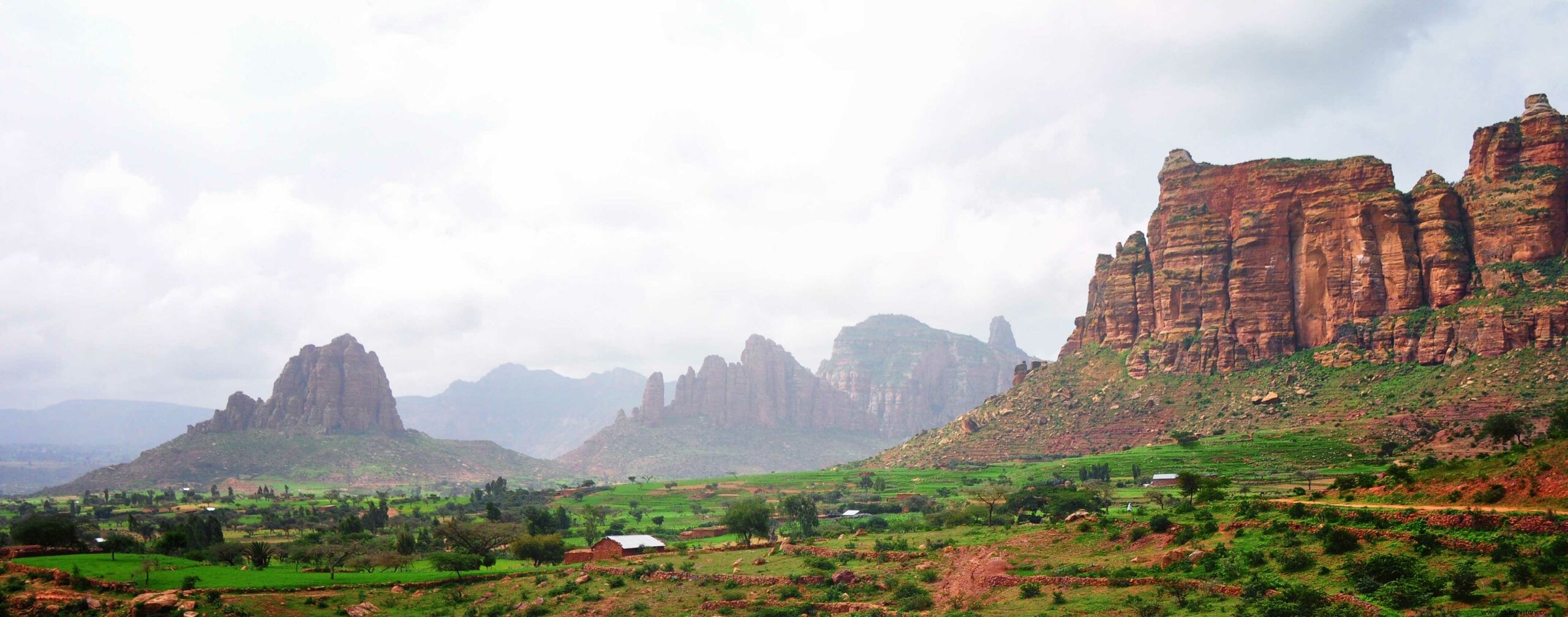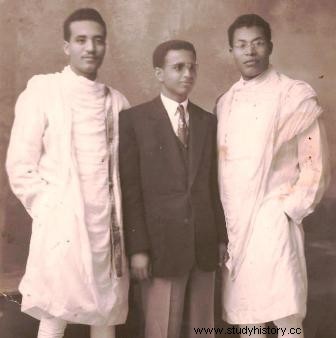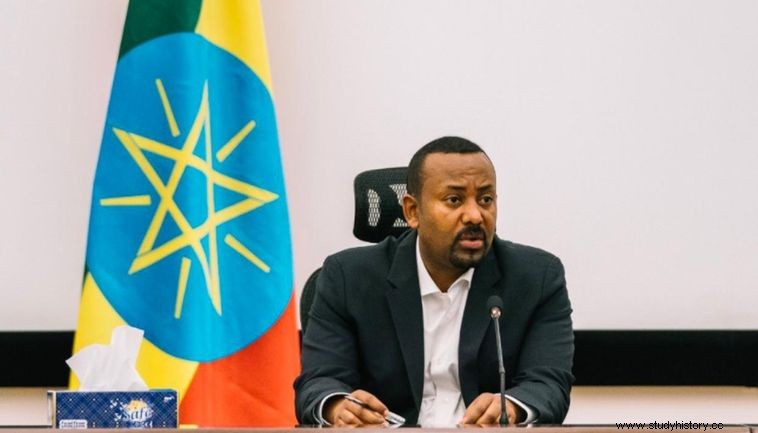History

With a history dating back centuries, Tigrayans living in the Tigray region of Ethiopia are an ethnic group with a population of approximately 7 million (as of 2020). They are the fourth largest ethnic group in Ethiopia, after Oromo, Amhara and Somali.
For the last two thousand years, the emperors who have ruled Ethiopia have been either Amharas or Tigray. According to the country's history, Menilik (son of King Solomon) was the founder of the Ethiopian Empire. The story goes that the Ark of the Covenant was captured by Menilik and his men from the Israelites, who were then brought to Aksum and what is today known as Tigray.
Language
Tigrayans speak Tigrinya, the official mother tongue of the region. Tigrinya is a language of the Ethiopian Semitic language family and related to Hebrew, Arabic and Aramaic (languages derived from the Syrians in Syria). Tigrinya is also closely linked to the official language of Ethiopia, Amharic. This means that most Tigrayans have no problem communicating in Amharic as well. Most of the letters used as you write these languages are a derivation of the ancient Geez language. Tigrinya itself has different dialects that are different both grammatically and phonetically. No single dialect is considered standard.
Religion


Before the advent of Christianity, the majority of the natives believed and followed pagan worship. The gods included Utu (the sun god) and Almaqah (the moon god). Judaism was also practiced by certain tribes in the group. D'mt and early Aksum were the most important polytheistic (belief in several gods) kingdoms.
Contrary to popular belief, Christianity was not introduced in Tigray upon the arrival of colonialism or missionaries. The Mediterranean world included Aksum and Adowa, both cities in the Tigray region. This is where Christianity came and grew around at the same time as in Ireland. According to records, the Tigrayans began to convert to Christianity a hundred years before such influence was seen in Europe. Today, the majority of Christians are native Oriental Orthodox, while a minority are Catholics. Religion and church are intertwined in the daily lives of the natives. Many churches in the country were carved into the rocks, while others were built of single blocks of stone. Every Tigrayan community has a church and a patron saint.
The Tigrais were introduced to Islam when the Prophet Muhammad and his followers took refuge in the kingdom of Aksum. When many of these followers returned to the Arabian Peninsula, many remained. Many of the natives were influenced by Islamic practices and soon converted to Islam. The new converts became known as Jeberti. Almost all Muslims in Tigraya are Sunni Muslims.
Traditional clothing


When it comes to attire, there is not much difference between it in the Tigray region and Ethiopia. White clothing is considered traditional and Christian, with the least possible embellishment.
For festive occasions and churches, women choose to wear long dresses that extend to the ankles. Women in some central and northern areas make their clothes from a material called shemma. A cotton cloth about 90 cm wide, made by weaving long strips of cloth together. These strips are then sewn together. The clothes made of shemma are called habesha kemis. On some occasions, shiny thread is woven or added to the fabric, which gives an elegant effect. The lower part of the dress may have patterns embellished into it. To produce enough clothes for a single dress, it takes at least two or three weeks.
Women often wear shawls, netela or shash. The shash is tied at the neck. The shash is made of a material called shama or kuta. Both Muslim and Christian women wear this garment. While the oldest members of the community wear the shash every day, younger women choose to wear the shash or shawl only during church. While at church, the shash is worn so that the shoulders are wrapped around the upper ends. This way of wearing the shawl gives a cross (meskelya). The blank threads appear at the edge. For gloomy occasions such as funerals, it is worn so that shiny threads are at the bottom (food dough). Accessories such as necklaces and bracelets made of silver or gold adorn arms and feet. Today, modern dress combined with traditional elements is made and worn by women in the cities.
The men's trousers are ankle-length. The upper part of the trousers (above the knee and hips) is loose and baggy, while it is tight from the knees to the ankle. Long-sleeved shirts are used. The shirts have a white collar, and sometimes a sweater is used. Knee-high socks are used. For ordinary men the shirt extends to the knees, while for priests it is below the knees. The men also have shawls around their shoulders. Today, many natives have thrown away their traditional clothing to adopt Western wear.
Festivals


Tigray's main festival is Ashenda Mariam, a festival reserved for girls and younger women. The festival takes its name from the tall grass that women use to adorn their dresses. Other names at the festival are Shadey, Solel, Mariya and Ashendye.
Ashenda is celebrated by Orthodox Christians and takes place at any time between August and September each year. The duration of Ashenda varies between the different localities. So it can last from a few days to even a whole month. The festival commemorates the heavenly inauguration of the Virgin Mary after her dormitory. Christians also use the opportunity to mark the end of a fasting period called filseta.
The main aspect of the festival, however, is the girls and young women in the region. According to Tigrayan culture, it is on this occasion that the girls (at the appropriate age) dress up and dress up to show off their beauty and dancing skills. The goal is to attract freer and get married before the next sowing season. Sometimes the girls wear a dress called tilfi. The tilfien is a cotton dress, front which is beautifully embroidered from top to bottom. From the waist down, the dress is decorated with tall grass known as ashenda. In addition to the elaborate dress, jewelry and special hairstyles are worn. The girls and women meet in a central place where they are divided into several smaller groups. The girls then entertain the community by going from house to house, singing and dancing. Drumming and socializing are also part of the culture. The songs sung for the festival vary from those who appreciate Ashenda, love songs, Christian songs and songs that appreciate beauty. It is common for people to give girls gifts. This can vary from money to food and drink. The custom of the girls lasts all day and the whole festival.
Folklore
Folk tales, poetry, puns and riddles are highly respected in society. Legends of ancient heroes are told through poetry. The art of 'poetic struggle' or qene is sought after in the tribe. A monastery-educated person is often employed in the community to show the poem's compositional abilities during public gatherings or festivities. They are also employed during weddings to entertain guests. Their poetry will be filled with puns and riddles that can often ridicule all sorts of unwanted traits in a person.
Verbal skills and ingenuity are also praised in the royal and sacred figures. Ethiopian folklore is filled with tales of saints. According to a legend, Tekle Haymanot, the Ethiopian saint, defeated the devil with his verbal skills. Gebre Memfis Qudus was a monk who was raised to the weekend because of his overwhelming compassion. Legend has it that the monk wandered among the wild beasts. His compassion was shown during one of Ethiopia's droughts. After a bird died of thirst, the monk cried and extinguished the bird's thirst with tears. According to legend, the bird was the Holy Spirit.
Mat

The food of the Tigrayans usually consists of local vegetables and meat prepared into an extremely spicy dish known as tsebhi. It is a thick stew served with sourdough flatbread called injera. Another regional court is tihlo. It is made with moistened fried barley flour which is kneaded and then broken into smaller forms. These are then served with the spicy meat seam. A wooden fork is used to dip the pieces in the stew. Mes (honey wine) is also served with the dish.
Orthodox Christians and Muslims do not use pork, as it is contrary to their religious beliefs. On Wednesdays and Fridays and during Lent, meat and dairy products are not served or eaten. To compensate for such religious beliefs, vegan meat is readily available in the region. It is common for the indigenous families and guests to eat from a shared food basket (masob). Cutlery is not used. The food is eaten with the right hand while the flatbread is used to scoop up the contents.
Society and gender roles
Men were the sole breadwinners and the head of the family. Until recently, laws said that men were disciplinary of children and owners of their wives. It was not until 2000 that re-enacted laws gave women rights regarding children, property and divorce. Divorced women are not looked after kindly in society. The marriage age was also raised from 15 to 18 in 2003.
While girls were not allowed to go to school after their basic education, the government now encourages them to be educated and join the public workforce. Politics in Tigray is a more male-dominated field. Modern influences and local problems have led to many changes in the region. Economic disadvantages have affected women to work outside their homes, with men sharing household responsibilities.
Today's War



Although Ethiopia is no stranger to the war and its aftermath, recent outbreaks in Tigray have left the country and its natives struggling. A protracted bloody conflict between government forces and troops led to countless civilian deaths and others fleeing their homeland broke out in November and continues to this day. As life's often cruel irony, the conflict came just a year after Ethiopia's Prime Minister Abiy Ahmed was awarded the Nobel Peace Prize for resolving a border dispute that spans twenty years.
Since PM Abiy took office in 2018, ethnic groups in Tigray and TPLF have resisted his attempt to unite the country through an increase in central government power. In September, when the PM canceled the election due to the pandemic, the TPLF set up its own elections. PM Ahmed rejected the election and the results, with the government further threatening to cut funding for the TPLF, thus irritating the leaders.
In November, Prime Minister Ahmed deployed troops to Tigray's northern military base (on the borders of Eritrea and Sudan). According to him, the ruling part of the region, the Tigray People's Liberation Front (TPLF), had attacked the base. Days later in a television broadcast, he announced that the facility had been bombed as a defense by the Ethiopian military. Shortly afterwards, Tigray and its neighboring regions were caught up in the still raging war, which caused civilians to pay with their lives and land. Thousands have fled to Sudan, where refugee camps were forced to reopen after twenty years. Those who remained lost their homes. According to the UN, humanitarian services could only access around 30% of the affected parts. Many health facilities were looted and damaged. Severe shortages of food, water and medicine have also been reported.

The parliamentary elections in June have already raised eyebrows. Speculations question whether the election would be a peaceful election, given the country's political unrest.
